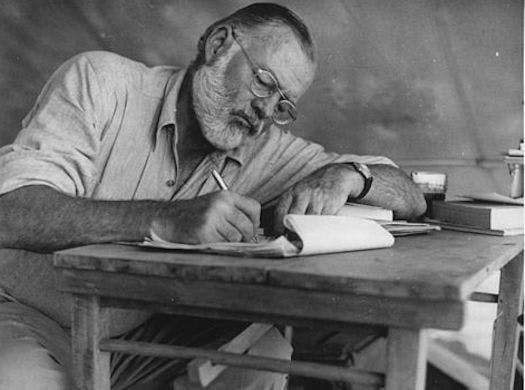A Starter Biography, ‘Hemingway’s Passions’ Is Behind the Times
Nancy W. Sindelar’s economically told narrative breaks no new ground and is written as if the last decade in Hemingway biography had not happened.

‘Hemingway’s Passions: His Women, His Wars, and His Writing’
By Nancy W. Sindelar
Foreword by Mariel Hemingway
Lyons Press, 248 Pages
Ernest Hemingway died in 1961 and yet in just the last decade there have been five full-length biographies of the author, not to mention books on his wives, his boats, and even his cats. What Nancy W. Sindelar contributes is an economically told narrative — call it a starter biography for those not in the know — that breaks no new ground and is written as if the last decade in Hemingway biography had not happened.
Hemingway’s passions are pursued in swiftly paced chronological order, beginning with Agnes von Kurowsky, who nursed the wounded Hemingway in a World War I hospital. He fell in love with her, but he was just a boy, she decided, and ended their love affair and broke his heart. Ms. Sindelar has nothing to say about his conflicting accounts of what actually happened to him in the war, or about how he tended to exaggerate and sometimes lie about his heroism, as disclosed in biographies by Richard Bradford (2020) and Curtis De Berg (2024).
The patient first wife, Hadley, with her handy trust fund that supported Hemingway while he wrote his first great novel, “The Sun Also Rises,” appears as she always does in Hemingway biography: the exemplary spouse whom Hemingway regretted abandoning for his no. 2, Pauline Pfeiffer.
Pfeiffer also had access to wads of money that enabled Hemingway to go on a $25,000 safari in the early 1930s and write about it in “The Green Hills of Africa,” which critics deemed inferior work to “A Farewell to Arms,” the novel that made Hemingway a best-selling author. Even after dying her hair blonde, Pauline lost out in competition with Jane Mason, who was one of the women on the side that Hemingway was always looking for.
When Hemingway tired of Mason, Pfeiffer made way (under protest) for the even more glamorous Martha Gellhorn, who has been written about in several biographies that Ms. Sindelar does not deign to mention in her notes or her bibliography, except for the groundbreaking book by Bernice Kert, “The Hemingway Women.” (1983) Ms. Sindelar apparently did not examine the Gellhorn archive at Boston University, which made Amanda Vaill’s “Hotel Florida: Truth, Love and Death in the Spanish Civil War” (2014) such an important work. It is unacknowledged in the apparatus of “Hemingway’s Passions.”
The last wife, Mary, stuck it out to the point of becoming Hemingway’s literary executor, and she gets serviceable treatment in Ms. Sindelar’s brisk biography, if not the fulsome treatment accorded in Timothy Christian’s “Hemingway’s Widow” (2022).
In her Acknowledgments, Ms. Sindelar mentions only James Mellow’s 1992 biography as helpful, though she also lists works by Carlos Baker (1969), Jeffrey Meyers (1985), Kenneth Lynn (1987), and Michael Reynolds (1980, 1986, 1999) in her bibliography. Ms. Sindelar is a board member of the Ernest Hemingway Foundation of Oak Park, teaches a course on “Hemingway’s Women,” and has keynoted Hemingway festivals, yet this book — even with an endorsement by Mariel Hemingway — seems behind the times.
Should a complaint about the provenance of a biography matter? It does, for example, when Ms Sindelar discusses the Spanish Civil War, during which Hemingway and Gellhorn bonded as fervent antifascists.
Ms. Sindelar’s lean account obfuscates the gruesome complications of the Hemingway/Gellhorn brand of antifascism. She mentions the atrocities of the Spanish Republicans perpetrated against priests, but not the deliberate refusal of Hemingway and Gellhorn to reckon with the brutality of the Communists who eliminated anyone on the left who they did not deem sufficiently supportive of the party line.
Absent from the Spanish Civil War story as Ms. Sindelar relates it is John Dos Passos, rebuffed by Hemingway when Dos Passos tried to show to his friend that some of those heroic Communist antifascists were murderers of fellow antifascists, including a Dos Passos friend.
Sometimes brevity in biography can badly distort the complexity of duplicitous lives like Hemingway’s. Ms. Sindelar does credit to his courage and to his great writing, and she reveals his self-indulgence and piggish behavior with women, and yet the true dimensions of his strengths and weaknesses seem diminished in the very narrative that claims his life was as great as his work.
Mr. Rollyson is the author of “Nothing Ever Happens to the Brave: The Story of Martha Gellhorn” (1990) and “Beautiful Exile: The Life of Martha Gellhorn” (2000).

